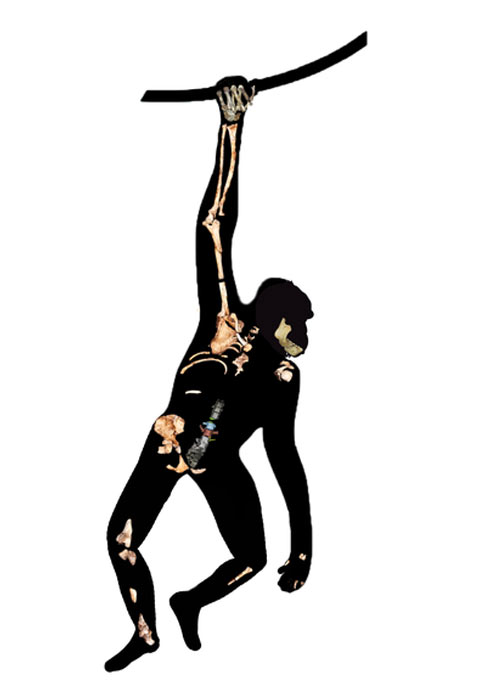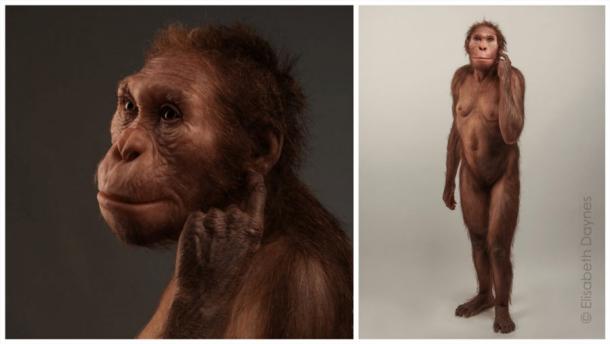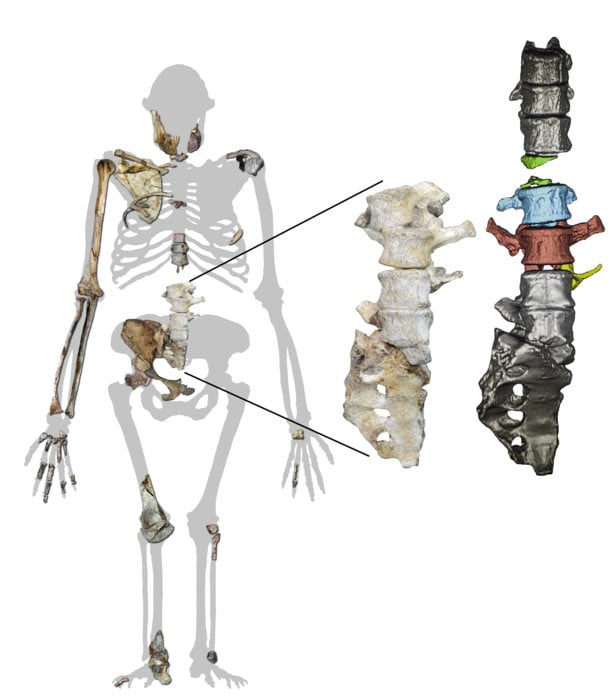A team of scientists has analyzed a set of two-million-year-old so-called ‘missing link’ fossils. Unlike anything presented before, their new study shows how the ancient human relative, Australopithecus sediba , ‘walked like a human, but climbed like an ape’. Is this the missing link Darwin dreamed of?
A collection of two-million-year-old fossil vertebrae from an early human relative, discovered in Africa, has finally put to bed a long outstanding anthropological debate. The argument had always been whether Australopithecus sediba could both walk and climb trees, or not.
Now, a new paper shows that this early hominin was like a cat, being a master of both vertical and horizontal planes. The researchers have demonstrated how A. sediba used its upper limbs to climb trees and cliffs, while their lower limbs powered them along, walking like humans.

Australopithecus sediba silhouette showing the newly-found vertebrae (colored) which is the spinal missing link, along with other skeletal remains from the species. (© NYU & Wits University )
Discovered In Africa’s ‘Cradle Of Humankind’, Of course
The team of researchers from New York University, the University of the Witwatersrand, and 15 other academic institutions around the world, published their findings in the open access journal e-Life. The study was based on two discoveries of ‘lumbar vertebrae from the lower backs’ of a male and female Australopithecus sediba.
According to a New York University release , in 2008, Professor Lee Berger from the University of the Witwatersrand and his son, Matthew, first discovered the two million years old fossilized spine of the new species of ancient human relatives. Researchers call this female skeleton “Issa,” which means ‘protector’ in Swahili, after she was found at Malapa Cave, in the self-proclaimed Cradle of Humankind World Heritage Site northwest of Johannesburg, South Africa.

The female Australopithecus sediba skeleton was named ‘Issa’, meaning Protector in Swahili. (Elisabeth Daynes / Wits University )
Then, in 2015, anthropologists discovered ’the most complete lower back ever discovered’ of a male sediba at the same site. Together, the two sets of vertebrae have been used to successfully demonstrate that our ancient human relatives climbed like animals and walked like modern humans.
‘Virtually Preparing’ Two-Million-Year-Old Fossils
The fossils were encrusted in breccia, a cement-like rock, so, to avoid damaging the fossils, they were scanned with a Micro- CT scanner at the University of the Witwatersrand. Once the fossilized vertebrae had been ‘virtually prepared,’ they were then pieced together with other fragments of fossils recovered at the site. The 2008 and 2015 vertebrae were found to ‘articulate perfectly’, according to the study.
Professor Scott Williams of New York University and Wits University, the lead author on the new paper, said the lumbar region ‘is critical to understanding the nature of bipedalism in our earliest ancestors. Moreover, lumbars inform scientists as to whether any given species could walk on two legs, like modern humans do. Previous lumbar studies were all based on incomplete lower spines. Until now, it was not noticed that sediba had ‘a relatively straight spine, without the curvature, or lordosis, typically seen in modern humans,’ according to the paper.

Australopithecus sediba silhouette showing the newly found vertebrae along with other skeletal remains from the species. (© NYU & Wits University )
Lordosis Of The Ancient Humans
Professor Gabrielle Russo of Stony Brook University was a coauthor of the new study and he explained that ‘Lordosis’ is the inward curve of the lumbar spine associated with tendencies towards bipedalism. The research showed how the lordosis of sediba was ‘more extreme than any other australopithecines yet discovered.’ This indicates ‘a powerful trunk musculature, perhaps for arboreal [tree climbing] behaviors,’ according to Russo. And, Issa’s spine was found to be more similar to ‘Neanderthals, and other more primitive species of ancient hominins older than two million years’.
The study concluded that the new spine research demonstrates sediba’s ‘transitional nature’ being able to walk like a human and climb trees like an ape: ‘a missing link’ showing another intermediate species between the great apes, Neanderthals and modern humans.
Top image: Life reconstruction of Australopithecus sediba commissioned by the University of Michigan Museum of Natural History. Sculpture by Elisabeth Daynes. Source: S. Entressangle / Wits University
By Ashley Cowie
Related posts:
Views: 0
 RSS Feed
RSS Feed

















 November 25th, 2021
November 25th, 2021  Awake Goy
Awake Goy  Posted in
Posted in  Tags:
Tags: 
















